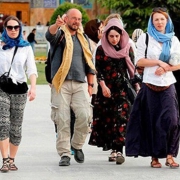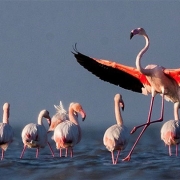What is the Dress code in Iran?
Iran Dress Code
Many prospective travelers that want to visit Iran, worry about the dress code here. Reading reports or watching carefully picked media footage makes most western people think women should be walking around like black wrapped-up mummies in Tehran. A funny image of Iran dress code!
Yes, due to Iran being the Islamic Republic, there is an appropriate dress code to be followed. It should be complied with in public spaces and businesses open to the public. And yes, it is enforced by the law, and like any good traveler special care should be taken to respect the law when you visit a new country. But to say that you should worry about it sounds a little bit… panicky?
Let me explain to you the Iran dress code, and why it’s not that much of a hassle.
Iran Dress code for Men:
- Long pants to the ankle.
- No sleeveless t-shirts.
Iran Dress code for Women:
- Long pants to the ankle.
- A scarf for at least partially covering your head and your neck.
- A manteaux or long shirt or tunic that covers your bum and chest or, in more elegant words, “hides the shape of the body”.
- Shirts or manteaux must have sleeves that cover your arms up to the elbow.
That’s it. Have fun in Iran!
In different cities or towns of Iran, Iranian ladies’ outfit is different, but you do not need to worry about this diversity, you can wear a standard outfit that you are more comfortable with during your visit to different cities.
“But, can I wear makeup?”, ”Should the scarf be black?”, “Can the pants be leggings?”, “Can men wear a tie?”, “Is it possible to wear sandals?”…. Relax!
The only rules are the ones written above five rules in total. If you have questions, look above. If your question isn’t being addressed there, then you should not worry about it.
For the sake of a more general answer, if you really have to insist, the primary precept of Islam that this dress code is supposed to invoke is “modesty”. Whether man or woman, look technically modest about your body, and you’ll have no problems. You might want to look more modest if you go to famously religious cities to avoid some curious glances. And should any authorities approach you and tell you you’ve missed some small details, smile, nod, and gracefully do what you’re told.
So you might understand from the above that there is also a lot of space for you to fashion yourself up in many different ways.
When you come to Tehran, you’ll see that women who live in the historic center of the city dress in the more conservative chador. In the north and south of Tehran people wear completely different clothes, which should not make you fearful.
But if you still insist on more information about Iran dress code for ladies, here are more explanatory tips:
The scarf can have any color or pattern that you might wish. During the summer try to use super light material and light-colored scarfs. And during colder seasons you will appreciate a warmer material that would keep your head and neck warm. You are not required to cover all your hair, if bangs or other parts are showing don’t worry.
The body must be covered with loose clothing at least to the knee or mid-thigh length. You can wear baggy shirts on warm days and coats during the winter. You can also buy manteaux from stores and malls in Iran at an affordable price.
Jeans are absolutely fine and are very usual among Iranian ladies.
For footwear, there are no limitations. Sandals or open-toed shoes are no problem.
For visiting, shrines or mosques wearing a “Chador” is obligatory and you can rent them at that place or buy them at a cheap price in a store.
you can also wear your usual make-up in Iran.
In general, as a tourist lady, you can stay as stylish as you wish in all cities or towns of Iran as long as most of the hair is covered and the clothing is not too short or tight.
Are you planning to travel to Iran and looking for an Iran travel agency? Check out our Iran tours.



